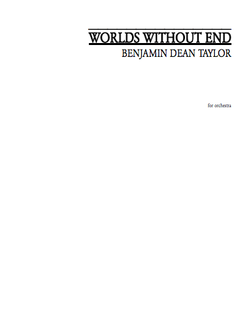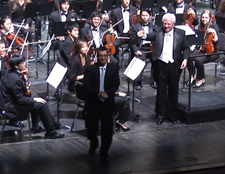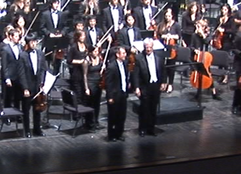Worlds Without End

Orchestra
3(pc).3.3(bcl).3(cbn)/4331/timp.3perc.hp.pno/strings
8 minutes
3(pc).3.3(bcl).3(cbn)/4331/timp.3perc.hp.pno/strings
8 minutes
PERUSAL SCORE
| worlds_without_end_perusal.pdf |
Program Note
The scriptural account of the creation of the earth has long been an inspiration to me as an artist. As I observe the world around me, I marvel at God's creation. The breadth of variety in animal and plant life; the beauty and majesty of forests, oceans, and mountains; the endlessness of stars, planets, and celestial bodies; and the complexity and power of the human body – all stand as supreme examples and inspiration to me when I embark on the artistic path of being a composer. And yet, we learn from scripture that our earth is but a small part of the wondrous creation. God revealed to his prophet Moses that he created worlds "without end." (Moses 1:4) God said, "And worlds without number have I created; . . . and by the Son I created them, which is mine Only Begotten." (Moses 1:33) Wow, this amazes me! Worlds without number? Worlds without end? I can't even fathom such an infinite number of creations.
As a composition, Worlds Without End is a one-movement work that stands as a tribute to God, the Creator of us all. As Dieter Uchtdorf, a counselor in the First Presidency of The Church of Jesus Christ of Latter-day Saints asserted, "Creation brings deep satisfaction and fulfillment. We develop ourselves and others when we take unorganized matter into our hands and mold it into something of beauty." I echo this sentiment. For me, the act of composing music brings peace, a sense of worth, greater meaning to my life, and ultimately makes me happy. I would not do it if I did not have fun! But creation is work, and each composition presents a unique set of challenges and problems I must overcome. The prolific composer Frank Ticheli once said, “No two pieces are composed in the same way, and with every new piece I must learn the creative process all over again.” I certainly felt this way while composing Worlds Without End. More so than with any of my other works, this composition has involved a gradual, slow process of formation. The act of generating musical materials, testing ideas, editing sections, refining orchestration, changing proportions, and notating the music has taken literally hundreds of hours. While at times frustrating and stressful, the composition process has ultimately been extremely rewarding as it has given me the chance to develop and grow as a creator.
As I wrote Worlds Without End, I thought of it as mirroring the creation process of a universe. The piece begins with a sparsely orchestrated melodic line which conveys unorganized gases and particles of matter slowly starting to coalesce in space. Further materials are added and ordered. There are many large explosions throughout the piece as matter combines and recombines, sometimes violently, other times in a mysterious or quirky manner. The climax of the work represents the culmination of the creative process, where all the ideas now finally fit together and are resolved harmonically. The conclusion of the composition brings back materials from the opening, representing the cyclical nature of creation as all matter passes through the rhythm of life, death, and rebirth.
The scriptural account of the creation of the earth has long been an inspiration to me as an artist. As I observe the world around me, I marvel at God's creation. The breadth of variety in animal and plant life; the beauty and majesty of forests, oceans, and mountains; the endlessness of stars, planets, and celestial bodies; and the complexity and power of the human body – all stand as supreme examples and inspiration to me when I embark on the artistic path of being a composer. And yet, we learn from scripture that our earth is but a small part of the wondrous creation. God revealed to his prophet Moses that he created worlds "without end." (Moses 1:4) God said, "And worlds without number have I created; . . . and by the Son I created them, which is mine Only Begotten." (Moses 1:33) Wow, this amazes me! Worlds without number? Worlds without end? I can't even fathom such an infinite number of creations.
As a composition, Worlds Without End is a one-movement work that stands as a tribute to God, the Creator of us all. As Dieter Uchtdorf, a counselor in the First Presidency of The Church of Jesus Christ of Latter-day Saints asserted, "Creation brings deep satisfaction and fulfillment. We develop ourselves and others when we take unorganized matter into our hands and mold it into something of beauty." I echo this sentiment. For me, the act of composing music brings peace, a sense of worth, greater meaning to my life, and ultimately makes me happy. I would not do it if I did not have fun! But creation is work, and each composition presents a unique set of challenges and problems I must overcome. The prolific composer Frank Ticheli once said, “No two pieces are composed in the same way, and with every new piece I must learn the creative process all over again.” I certainly felt this way while composing Worlds Without End. More so than with any of my other works, this composition has involved a gradual, slow process of formation. The act of generating musical materials, testing ideas, editing sections, refining orchestration, changing proportions, and notating the music has taken literally hundreds of hours. While at times frustrating and stressful, the composition process has ultimately been extremely rewarding as it has given me the chance to develop and grow as a creator.
As I wrote Worlds Without End, I thought of it as mirroring the creation process of a universe. The piece begins with a sparsely orchestrated melodic line which conveys unorganized gases and particles of matter slowly starting to coalesce in space. Further materials are added and ordered. There are many large explosions throughout the piece as matter combines and recombines, sometimes violently, other times in a mysterious or quirky manner. The climax of the work represents the culmination of the creative process, where all the ideas now finally fit together and are resolved harmonically. The conclusion of the composition brings back materials from the opening, representing the cyclical nature of creation as all matter passes through the rhythm of life, death, and rebirth.
RENTAL and SCORE PURCHASE
This work is available as a rental. Please email [email protected] for a quote.
The Score may be purchased at the link below. (This is a full size 11x17 inch performance score). Free shipping is included in the price.
The Score may be purchased at the link below. (This is a full size 11x17 inch performance score). Free shipping is included in the price.

